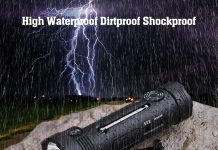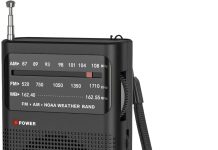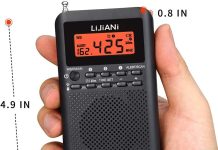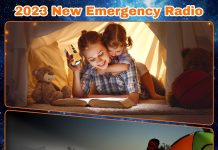In this article, we explore the fascinating world of emergency weather radios and whether or not they come equipped with SAME technology. With the increasing prevalence of severe weather events, it is essential to have reliable and accurate information to keep ourselves and our loved ones safe. But what exactly is SAME technology and how does it enhance the functionality of these life-saving devices? Join us as we delve into the world of emergency weather radios and uncover the answer to this important question.
Review contents
What is SAME technology?
Definition of SAME technology
SAME technology, which stands for Specific Area Message Encoding, is a technology used in emergency weather radios to provide targeted and accurate weather alerts. It is a system that allows emergency management agencies to send alert messages to specific geographical areas, ensuring that individuals receive critical information about severe weather conditions in their immediate vicinity.
Why is SAME technology important in emergency weather radios
SAME technology is crucial in emergency weather radios because it enhances the effectiveness and reliability of weather alerts. By utilizing SAME technology, weather radios can filter out unnecessary alerts and only broadcast notifications that are relevant to the specific location where the radio is being used. This targeted approach to alerting ensures that individuals receive accurate information about imminent weather threats, allowing them to take appropriate action to protect themselves and their property.
Types of emergency weather radios
Handheld emergency weather radios
Handheld emergency weather radios are portable devices that provide users with on-the-go access to critical weather information. These radios are compact and lightweight, making them convenient to carry during outdoor activities such as hiking, camping, or boating. Handheld models typically come equipped with a built-in speaker, headphone jack, and a display screen to view weather alerts and other features.
Desktop emergency weather radios
Desktop emergency weather radios are designed for stationary use within homes, offices, or other indoor environments. These radios often have larger and clearer screens than their handheld counterparts, allowing for easy visibility of weather alerts and other information. Desktop models may also come equipped with additional features like alarm clocks, AM/FM radio functionality, and the ability to charge mobile devices.
Public alert radios
Public alert radios, also known as all-hazard radios, are primarily used in public spaces such as schools, government buildings, hospitals, and outdoor warning systems. These radios are designed to broadcast emergency alerts to a wide range of individuals in a specific location. They often have high-powered speakers to ensure that alerts can be heard clearly in public areas, even in noisy environments.
Features of emergency weather radios
AM/FM radio functionality
Many emergency weather radios come with AM/FM radio functionality, allowing users to listen to their favorite stations when there are no weather alerts or during non-emergency situations. This feature provides additional entertainment and keeps users connected to the world beyond weather updates.
Weather alerts
The main feature of an emergency weather radio is its ability to receive weather alerts. These radios can receive alerts issued by the National Weather Service (NWS) and other authorized agencies, providing up-to-date information on severe weather conditions such as tornadoes, hurricanes, and severe storms. Weather radios with SAME technology can filter alerts based on specific location codes, ensuring that users only receive alerts relevant to their area.
Battery power
Emergency weather radios are designed to operate even during power outages or in areas without electricity. They are typically powered by batteries, allowing them to function independently in emergency situations. It is essential to choose a radio with a long battery life or the option to use alternative power sources such as solar panels or hand cranks.
Antenna
An antenna is a crucial component of an emergency weather radio as it helps in receiving reliable and clear signals. Radios with a flexible and extendable antenna tend to have better reception, allowing users to receive weather alerts even in areas with weaker signals.
Display
The display of an emergency weather radio is vital for easily viewing weather alerts and other information. High-quality displays with backlighting or adjustable brightness make it easier to read the information, especially during nighttime or low light conditions. Some radios also offer color-coded displays to provide visual indicators for different types of weather conditions.
Understanding SAME technology in emergency weather radios
What is SAME technology?
SAME technology, an acronym for Specific Area Message Encoding, is an advanced system used in emergency weather radios to provide location-specific weather alerts. It allows emergency management agencies to target specific geographic areas, ensuring that individuals receive accurate and timely notifications about severe weather threats.
How does SAME technology work?
SAME technology works by utilizing a unique alphanumeric code assigned to each county or municipality within the coverage area of a weather radio. When an emergency alert is issued, the alert message is encoded with the corresponding county code. Weather radios equipped with SAME technology can then filter out alerts that do not match the programmed county code, preventing unnecessary or irrelevant alerts from being broadcasted.
Benefits of SAME technology in emergency weather radios
SAME technology offers several benefits in emergency weather radios. Firstly, it ensures that individuals receive quick and accurate weather alerts specifically tailored to their location. This targeted approach reduces the risk of misinformation and allows users to take appropriate action based on the severity of the weather threat. Additionally, SAME technology minimizes the number of unnecessary alerts received, preventing alert fatigue and improving the overall user experience.
Benefits of emergency weather radios with SAME technology
Quick and accurate weather alerts
One of the primary benefits of emergency weather radios with SAME technology is the ability to receive quick and accurate weather alerts. By utilizing location-specific codes, these radios filter out irrelevant alerts and only broadcast notifications that are relevant to the user’s immediate vicinity. This ensures that individuals are promptly informed about potentially dangerous weather conditions, allowing them to take necessary precautions or seek shelter in a timely manner.
Customized alerts based on location
Emergency weather radios with SAME technology offer customized alerts based on the user’s location. Each radio can be programmed with specific county codes, ensuring that users only receive alerts for their designated area. This targeted approach eliminates confusion and ensures that individuals receive only the most relevant information about weather emergencies in their immediate surroundings.
Reduced misinformation
By filtering out alerts that do not match the programmed county code, emergency weather radios with SAME technology significantly reduce the risk of misinformation. Users can trust that the alerts they receive are accurate and directly applicable to their location, minimizing unnecessary panic or confusion. This accuracy and reliability are especially crucial in situations where swift and informed decision-making can make a significant difference in personal safety.
Increased preparedness
With SAME technology, emergency weather radios provide an added layer of preparedness for individuals and communities. By receiving timely alerts about severe weather conditions, users have an opportunity to prepare and take appropriate action before the situation worsens. This can include seeking shelter, securing personal property, or making evacuation plans. The ability to stay informed and prepared can save lives and minimize damage during severe weather events.
Availability of emergency weather radios with SAME technology
Major brands offering emergency weather radios with SAME technology
Several major brands offer emergency weather radios with SAME technology, ensuring that consumers have a variety of options to choose from. Some popular brands known for their reliable weather radios include Midland, NOAA, Sangean, and Eton. These brands are widely recognized for their commitment to providing quality weather radios with advanced features, including SAME technology.
Online retailers selling emergency weather radios with SAME technology
Emergency weather radios with SAME technology can be purchased from various online retailers. Websites like Amazon, Walmart, and Best Buy offer a wide range of options, allowing users to compare features, prices, and customer reviews. Online shopping provides convenience, accessibility, and the opportunity to read detailed product descriptions and specifications before making a purchase.
Pricing of emergency weather radios with SAME technology
Factors affecting the price of emergency weather radios with SAME technology
The price of emergency weather radios with SAME technology can vary depending on several factors. These factors include the brand, the specific features and functionalities offered, the type of radio (handheld or desktop), additional accessories included, and the overall build quality. Radios from reputable brands with advanced features tend to have a higher price tag compared to basic models with limited features.
Average price range of emergency weather radios with SAME technology
The average price range of emergency weather radios with SAME technology typically falls between $30 and $100. Basic handheld models designed for personal use tend to be more affordable, while desktop radios with additional features may be at the higher end of the price range. It is important to consider the specific needs and budget when selecting an emergency weather radio, ensuring that it meets the desired requirements without breaking the bank.
Comparison between emergency weather radios with and without SAME technology
Benefits of emergency weather radios without SAME technology
Emergency weather radios that do not have SAME technology still offer valuable features and benefits. These radios can receive weather alerts from the National Weather Service and other authorized agencies, providing users with critical information about severe weather conditions. While they may not have the same level of customization and filtering as SAME technology radios, they still serve the purpose of providing timely and potentially life-saving alerts.
Drawbacks of emergency weather radios without SAME technology
The primary drawback of emergency weather radios without SAME technology is the lack of location-specific alerts. These radios typically receive alerts for a broader geographic area, which may include counties or municipalities that are not relevant to the user. This can result in receiving alerts for weather conditions that do not affect the user’s immediate surroundings, leading to alert fatigue and potentially diminishing the effectiveness of the radio.
How to choose the right emergency weather radio with SAME technology
Consider your needs and preferences
When choosing an emergency weather radio with SAME technology, it is essential to consider your specific needs and preferences. Determine the primary purpose of the radio, whether it is for personal use during outdoor activities or for stationary use in a home or office environment. Consider the desired features, such as AM/FM radio functionality, additional accessories, and power options. By understanding your requirements, you can select a radio that best suits your needs.
Read customer reviews
Reading customer reviews is an excellent way to gauge the quality and performance of emergency weather radios with SAME technology. Look for reviews from customers who have used the product in real-world scenarios and evaluate their feedback regarding the reception, durability, and overall user experience. Pay attention to any recurring comments or concerns, as this can provide valuable insights into potential issues or limitations of certain models.
Check for certifications and standards compliance
Ensure that the emergency weather radio you choose complies with industry standards and certifications. Look for radios that are NOAA Weather Radio All Hazards (NWR) certified, indicating that they meet the performance requirements set by the National Weather Service. Additionally, consider radios that have been tested and approved by recognized organizations such as the Federal Communications Commission (FCC) and the Occupational Safety and Health Administration (OSHA).
Compare prices and features
Lastly, compare prices and features of different emergency weather radios with SAME technology. Take into account the budget and prioritize the features that are most important to you. Consider the reputation and trustworthiness of the brand, as well as any warranties or guarantees offered. By comparing various options, you can make an informed decision and select the right emergency weather radio that provides the best value for your investment.
Conclusion
Emergency weather radios with SAME technology play a crucial role in keeping individuals informed and safe during severe weather events. By utilizing location-specific alerts, these radios provide quick and accurate information tailored to the user’s immediate surroundings. SAME technology enhances the effectiveness of weather alerts, reducing the risk of misinformation and improving overall preparedness. When choosing an emergency weather radio, it is important to consider factors such as features, pricing, and customer reviews. By selecting the right radio with SAME technology, individuals can stay informed, prepared, and protected during any unforeseen weather emergencies.



























